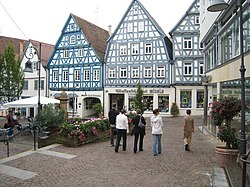Waiblingen
You can help expand this article with text translated from the corresponding article in German. (February 2009) Click [show] for important translation instructions.
|
Waiblingen | |
|---|---|
 Waiblingen | |
| Coordinates: 48°49′49″N 09°19′01″E / 48.83028°N 9.31694°E | |
| Country | Germany |
| State | Baden-Württemberg |
| Admin. region | Stuttgart |
| District | Rems-Murr-Kreis |
| Government | |
| • Mayor | Andreas Hesky (Ind.) |
| Area | |
| • Total | 42.76 km2 (16.51 sq mi) |
| Elevation | 230 m (750 ft) |
| Population (2022-12-31)[1] | |
| • Total | 56,081 |
| • Density | 1,300/km2 (3,400/sq mi) |
| Time zone | UTC+01:00 (CET) |
| • Summer (DST) | UTC+02:00 (CEST) |
| Postal codes | 71331–71336 |
| Dialling codes | 07151, 07146 |
| Vehicle registration | WN, BK |
| Website | www.waiblingen.de |
Waiblingen (German pronunciation: [ˈvaɪblɪŋən]) is a town in the southwest of Germany, located in the center of the densely populated Stuttgart region, directly neighboring Stuttgart. It is the capital of the Rems-Murr district. As of December 31, 2018 Waiblingen accommodated 55,449 inhabitants (27,334 men and 28,115 women).
As of December 31, 2004, the area of the town (including all external properties, such as forests) was 42.76 km2 (16.51 sq mi).
History
Waiblingen was first mentioned in Carolingian documents in 885 at the time of Charles the Fat. It received its town charter in 1250.
Waiblingen was the property of the Salian kings, from whom the Hohenstaufen dukes and kings inherited it. It is assumed that the Italian name of the Hohenstaufen party, Ghibelline, is derived from "Waiblingen".
The town was almost completely destroyed in 1634 during the Thirty Years' War, and its citizens either killed or deported. It was rebuilt after the war; the existing old central part of the town dates back to the years between 1640 and 1700. Its fortifications are now well restored.
Incorporation
The following towns were incorporated into Waiblingen:
- December 1, 1971: Beinstein
- January 1, 1975: Bittenfeld, Hegnach, Hohenacker and Neustadt
Economy
Waiblingen houses the principal office of the world's biggest chainsaw manufacturer, Stihl. has two factories there, for polymer and packaging technology.
It is also the location for the letter processing center for the Stuttgart region of the Deutsche Post.
International relations
Waiblingen is twinned with:[2]
Notable people
- Alessandro Abruscia (*1990, Waiblingen), an Italian-German footballer
- Katrin Altpeter
- Jakob Andreae
- Giuseppe Catizone (*1977, Waiblingen), an Italian and German footballer
- Markus Groh (*1970, Waiblingen), a German pianist[3]
- Werner Haupt
- Claus E. Heinrich
- Giorgos Machlelis (*1991, Waiblingen), a Greek-German footballer
- Bernd Mayländer
- Christian Mergenthaler
- Athanasia Moraitou
- Matthias Morys
- Christoph Niemann
Honorary citizens
- 1883: Dr. med. Gustav Pfeilsticker
- 1907: Ferdinand Küderli
- 1930: Theodor Kaiser
- 1932: Friedrich Schofer
- 1934: Albert Roller
- 1953: Emil Münz
- 1967: Alfred Diebold
- 1968: Adolf Bauer
- 1997: Dr. Ulrich Gauß
- 1997: Hans Peter Stihl (*1932, Stuttgart), a German industrialist (Stihl)
- 1997: Albrecht Villinger
References
- ^ "Bevölkerung nach Nationalität und Geschlecht am 31. Dezember 2022" [Population by nationality and sex as of December 31, 2022] (CSV) (in German). Statistisches Landesamt Baden-Württemberg. June 2023.
- ^ "Städtepartnerschaften". waiblingen.de (in German). Waiblingen. Retrieved 2019-12-02.
- ^ official site
External links
![]() Media related to Waiblingen at Wikimedia Commons
Media related to Waiblingen at Wikimedia Commons
- Chisholm, Hugh, ed. (1911). . Encyclopædia Britannica (11th ed.). Cambridge University Press.





